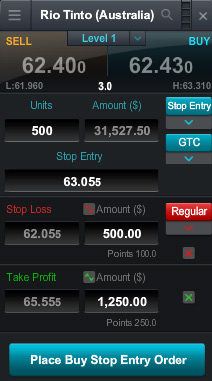If you are new to CFD Orders, then please ready CFD Order Types before reading CFD Order Tricks.
CFD brokers in Australia all have similar CFD order types as outlined below. What you need to be clear on with your CFD broker is how they execute the various CFD order types into the market.
Let’s take a quick look at a CFD order type where you want to get out if the price trades below $10.
Your CFD order would be described as a Stop to exit at $10.
The reason you placed this trade is to limit your loss just in case the CFD trades at or below $10. Unfortunately what can happen with some CFD brokers is that when the CFD hits $10, your order becomes a Limit to Sell at $10 exactly.
Bid | Ask |
|---|---|
$10.02 |
|
$10.01 |
|
$10.00 |
|
$9.99 | |
$9.98 | |
$9.97 |
In the market depth example above the market hits $9.99 – $10.00 and your order would be set at $10.00 waiting for a buyer to hit your order. But what if no-one bids $10.00 or higher?
If in the worst case scenario, the market continues to go down and ticks to $9.99 then $9.98 then $9.97, your order will still be sitting there waiting to be triggered at $10.00.
This can be a nasty surprise in bearish markets when you thought your CFD order to sell at $10 would have been hit.
It wouldn’t be unheard of to have 1,000 CFDs to sell, and your $10 CFD order didn’t get triggered and the price continued down to $9.50, giving you an additional loss of $500 you weren’t expecting.
Make sure your CFD order with your CFD provider allows you to sell at $10 OR LESS.
When getting started in CFD trading, it is vital that you ask your CFD broker if your CFD order to sell gets set at $10 or less. That means your CFD broker will STOP you out if the price hits any price at or below $10.00.
This is very important and could save you hundreds, if not thousands of dollars.
Another CFD order type to watch out for is a limit to sell when looking to take profits. So in this example, you would be in the market at say $9.50, and you set your CFD order for a profit target of $10.00.
Limit to Sell CFD Order with CFD Broker A: The market trades up to your $10 CFD order. Your order gets set at $10.00, and you are next in line. Several orders come through to buy at market and your CFD order gets triggered, and you take profits at $10.00.
Limit to Sell CFD Order with CFD Broker B: The market trades up to your $10 CFD order. This CFD provider requires that the BID price hit $10.00 before your CFD order gets set and ONLY IF your volume goes through at $10.00 or higher. HUH?
Why this CFD order hurts – Reason 1: It is possible in this scenario for the market to trade several thousand shares at $10.00 only to fall away for the rest of the day. If the price never gets back to $10, then you are still long, and your CFD order (profit target) never got hit. You missed out on taking profits.
Why this CFD order hurts – Reason 2: In this scenario, the CFD broker sees your CFD order to exit at $10 and the quantity of shares you have.
There have been times during market volatility where prices trade at prices above your exit price. The BID price was $10.00, and your quantity of CFDs went through. However, the CFD broker didn’t close your position.
So you phone them up asking for an explanation, and they say words to the effect: “Yes the bid price did get to $10.00. However, there were several CFD orders, and you were not 1st in line. Unfortunately, we couldn’t get you out. Would you like to keep that CFD order to sell in place?”
Important questions to ask your CFD broker
Q1. When placing stop-loss orders do you get my CFD order out at my nominated price or below? Or does the order become a limit to sell at my price?
Answer: Should be a definite YES or run the other way.
Q2. When I place a limit to sell order – profit target (remember some CFD Brokers only sell you if the BID price is at your level or higher) does my exit price have to be on the BID or higher?
Answer: Ideally you don’t want a situation where your exit price has to be on the BID. The reason is there may be ample quantity going through at your exit level but never breaks through.
This can be very important if you use support and resistance to make your trading decisions.
Hopefully, you don’t get stung with any odd CFD order types. But you do need to be aware of these so ask the question of your CFD broker first and get the full picture.